Dead pull versus inside-out
One of my favorite data visualizations among those created by the baseball analysts community is certainly Dave Allen‘s parallel coordinate plot, which shows batters’ spray tendencies related to the horizontal location of pitches.
Here are the Allen Plots (why not name them after their creator?) for two different kind of batters.
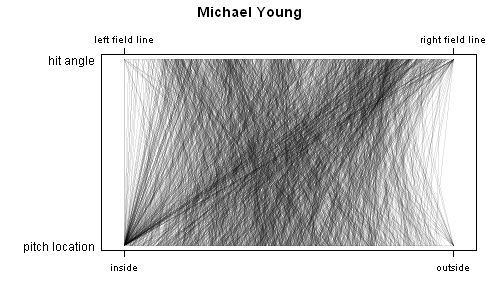
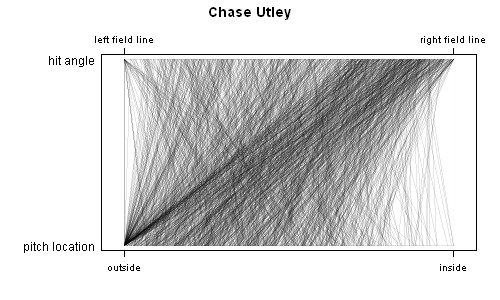
Both charts show a prevalence of lines going bottom-left to top-right, despite Michael Young batting right handed and Chase Utley swinging from the left side. In fact Young is a notorious inside-out swinger, while Utley has a predilection for pulling everything—prompting the Rays to play him extremely shifted during the 2008 World Series.
The HWP Index
I have created an index to indicate the angle of a batted ball in relation to where it was pitched. I will refer to it as the hit-where-pitched index, or HWP.
The HWP index ranges from -1 to 1, where -1 indicates an outside pitch (one foot or more from the middle of the plate) driven along the left field line (if the batter is right handed, otherwise along the right field line) and 1 indicates an inside pitch launched along the opposite field line. Values close to zero indicate balls “hit where they were pitched”: pitches down-the-middle sent to center, pulled inside pitches, outside offerings driven to the opposite field (i.e. the batted balls that would produce vertical lines in the Allen Plot).
Batters’ hit-where-pitched tendencies can be summarized by averaging the HWP indexes of their balls put in play.
Here is a density plot of batters’ HWP (data 2007 to present, players with a minimum of 400 balls in play).
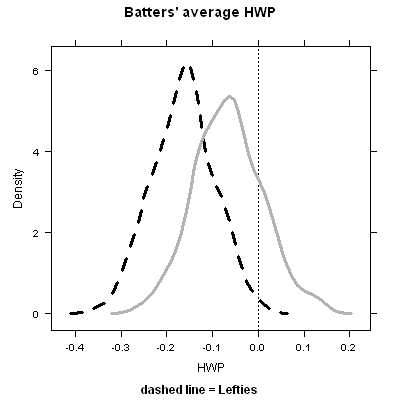
As one could have expected, the typical batter leans toward the pull side of the spectrum, with a minority of inside-out swingers. The aforementioned Michael Young is the poster boy for the group, and Derek Jeter also makes the list—a nice sanity check for the HWP index.
Left handed batters (dashed line in the plot) pull the ball definitely more than their right-handed peers (Joe Mauer is the only lefty with a HWP greater than zero).
All but three switch hitters among the qualifiers have a higher HWP when swinging from the left side (the exceptions being Alfredo Amezaga, Josh Bard and Tony Abreu).
One reason for the difference is certainly the different pitch mix lefties face: in fact, while other pitches are equally delivered to both kind of batters, portsiders are fed a few more change-ups (sliders are preferred for right-handed batters), and the change of pace is the pitch most likely to be pulled (see table below).
pitch type HWP
Change-up -0.28
Curve -0.22
Cutter -0.05
Four-seamer -0.01
Knuckle -0.14
Sinker -0.09
Slider -0.18
Splitter -0.25
Two-seamer -0.09
I would have expected the most powerful bats to be associated to the heaviest pulling. Instead Shane Victorino and Jimmy Rollins are close to the top from whichever side they are batting.
HWP and production
Let’s see how the HWP index relates to the batted ball outcome. Below, batted balls run values are plotted against HWP.
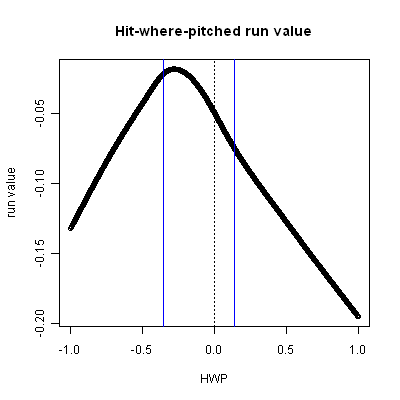
Again, the result is not surprising: highest values are to be found close to the middle (the “hit-where-pitched” zone), with a slight skew toward the pull side. The added vertical lines indicate the range of the average HWP (from the lefty version of Jimmy Rollins to Michael Young). Young appears to hit in a very non-optimal way, judging by the chart. However, not every batter is created equal (and we know Young is a pretty good hitter).
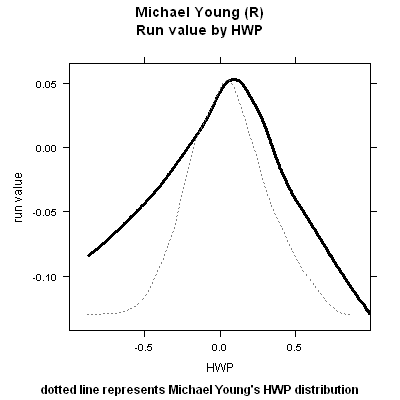
In fact, the above chart shows Young obtains the best (i.e. highest run value) for HWP very close to zero, actually a tick in the inside-out zone. And his HWP distribution (dotted line) maxes exactly there, making his hitting habits far from sub-optimal.
Nick Punto is another inside-out hitter when hitting from the right side, second in the HWP rankings right behind Young.
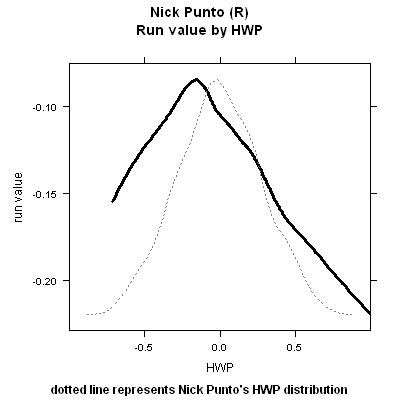
Looking at his HWP distribution and his run production by HWP, it looks like Punto would benefit from pulling the ball some more (His style is optimal when he swings from the lefties’ batter box).
As we said, not every batter is created equal. While Young’s best results come when hitting the ball inside-out, Mark Teixeira experiences his success when pulling the ball. The chart below depicts his numbers from the right side.
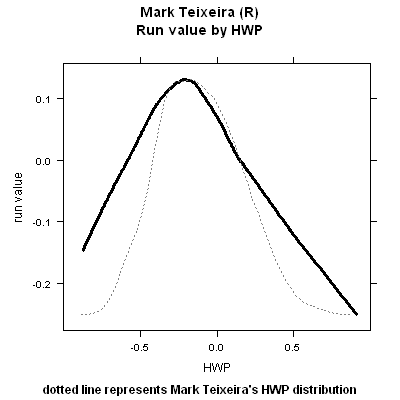
Tex’s style appears to be optimal as well.
A look from the pitchers’ perspective
There aren’t many pitchers who regularly induce opposite batters to hit inside-out. Of those few, most are successful against same- handed batters. For example, lefty specialist J.C. Romero is the best at making left-handed batters hit inside-out, while Fernando Rodney is his right-handed counterpart.
Among the rare pitchers who make opposite-handed batters hit inside-out, flamethrower Matt Thornton (more than 90 percent of his pitches are fastballs traveling on average over 95mph) and Darren Oliver, with his slider thrown nearly 40 percent of the time (according to FanGraphs), can be cited as the most prominent examples.
Only one pitcher induces inside-out swings against both right-handed and left-handed batters: It’s Mariano Rivera, and we already knew he is a pitcher on his own.
References & Resources
Pitch locations from PITCHf/x, hit angles from GameDay.

Great article Max!
This is excellent work, Max. The HWP index is a brilliant idea.
This is fantastic, Max. I’ll be there is a wealth of information in this data.
I haven’t seen anyone else looks at this data in such a way, Max. Terrific new perspective.
Max, very enjoyable analysis. If I understood everything correctly, this seems to be a dead-pull vs opposite way index. This is probably good enough for the real world. But if you truly want to know if pitches are being hit where pitched, I’d like to suggest a tweak. Right now, an imaginary hitter who pulled a lot of outside pitches and inside-outed a lot inside pitches (yes, totally unusual) would see positive and negative values for those cases cancel out. Assigning a zero if going with the pitch, but a one if inside pulled or outside hit opposite way would tell you a different story. Or you could just calculate your index separately for inside and outside pitches to see the dufference. I suspect both the original and the tweak would have their uses. Specifically, a batter who tries to pull too many outside pitches is different from someone who pulls because he gets pitched inside.
Thank you all for the kind comments.
TedK,
what you say is true, but as you hint there are no MLB hitters who pull outside pitches while dropping inside pitches the opposite way; also that would affect the batter’s average HWP, while his peculiar tendencies would emerge in the charts.
Studes,
regarding the wealth of information, imagine subtracting Gameday data and putting HITf/x in its place…